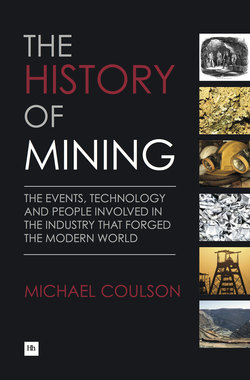Читать книгу The History of Mining - Michael Coulson - Страница 30
На сайте Литреса книга снята с продажи.
14. The Structure of Ownership and Operation
ОглавлениеToday the mining industry’s operating and ownership structure is largely settled. There are some government-owned mines but mining worldwide is dominated by private ownership where capital is provided by shareholders and banks, and a board of directors sits on top of an administrative and operating structure.
National and regional governments set tax and royalty rates and also provide a legal base for the industry’s operations through legislation. Governments may also make state land available for mining development. This more formal structure had been evolving since the Middle Ages as we will see later on. In the ancient world the situation was far less straightforward and thus less stable, although as we have shown the Roman Empire did have an organised structure for its mining industry.
In the ancient world there were two forms of mine operation – one related to the larger-scale mines which required the labour of slaves and where ownership was either in the hands of the Crown or aristocratic landowners. Where the mining operation was small scale the miners would usually pay a lease rent to the owner for mining the land, although it was not impossible for small miners to mine outcrops without recourse to ownership issues.
For areas like the mining of gold and silver, with their monetary aspects, the state often claimed all rights to any metal mined, and although rights to mine were given to miners the output would often have to be sold to the state at a price determined by the state. On the other hand, in Britain in the Middle Ages there are records of extensive purchases of lead in the commercial market by the Crown for the building of royal residences, indicating that the Crown, certainly in England, did not want to be involved in the mining process and was happy to fulfil its industrial metal requirements in the open market.
The profitability or otherwise of mines in the ancient world would have been affected by broadly the same issues as rule today – the cost of the inputs against the value of the metals extracted. Whilst some ancient mines operated for hundreds of years, there is evidence that on many occasions production was interrupted, often for years, indicating fluctuating financial returns.
The use of slaves in large mining operations would have obviously reduced operating costs considerably. For instance, the quarrying of stone to build the pyramids in Egypt would have been very labour intensive, as would the construction of the pyramids themselves, so a slave labour force would have boosted the economics of the venture considerably. The relative shallowness of most mines should have been helpful also and it is likely that the development of deeper mines was constrained by issues of engineering, water tables and geological factors, in addition to development costs.
As far as the economic importance of mining in the ancient world is concerned, strong data is difficult to find but it is possible to make some intelligent guesses. Agriculture and forestry were almost certainly the primary activities of most ancient economies, with manufacturing being confined to the essentials of life, including weapons and household items. Mining would have provided the raw materials for this manufacturing and also stone for building, but it is in the area of precious metals that its main impact would have been felt. Here the state had an overwhelming interest in obtaining gold and silver so that, in particular, wars of conquest could be financed.
The economic effect of acquiring large quantities of gold and silver is something we will come to later when we look at the Spanish conquest of parts of South America in the later Middle Ages. Suffice it to say at this stage that the huge inflation that accompanied the arrival of South American gold in Spain suggests that mining would have been a substantial industry in terms of its position within the economy. In the ancient world we could draw similar conclusions about the position of metals and minerals, including precious metals, in the economy of the expanding Roman Empire.
